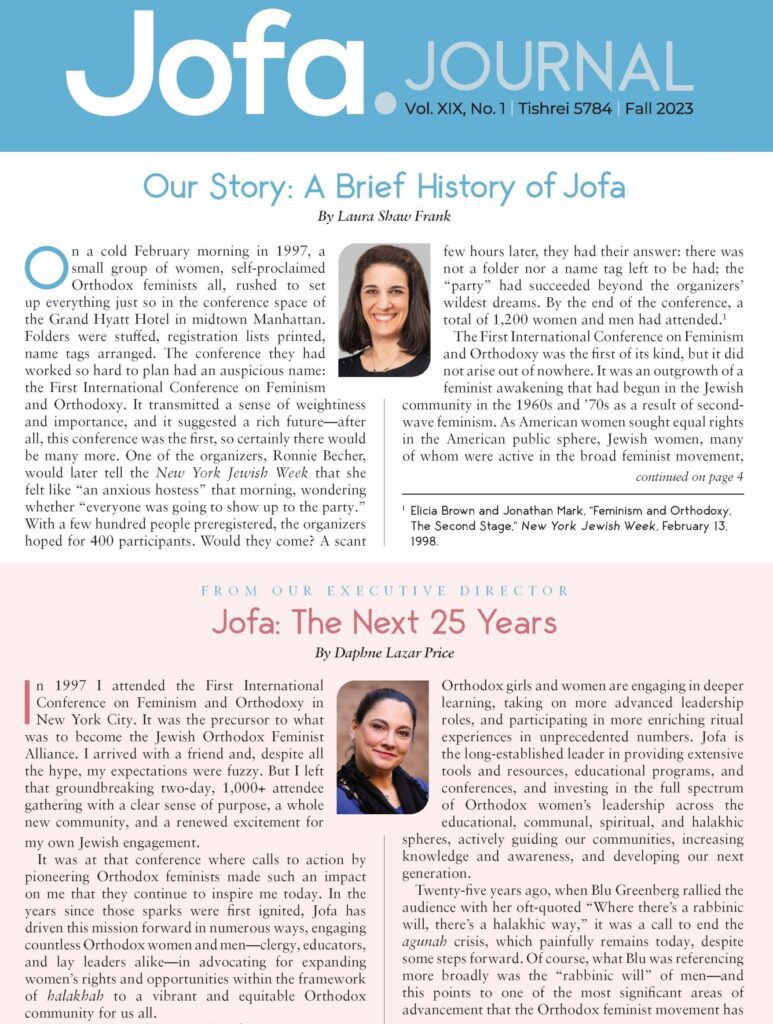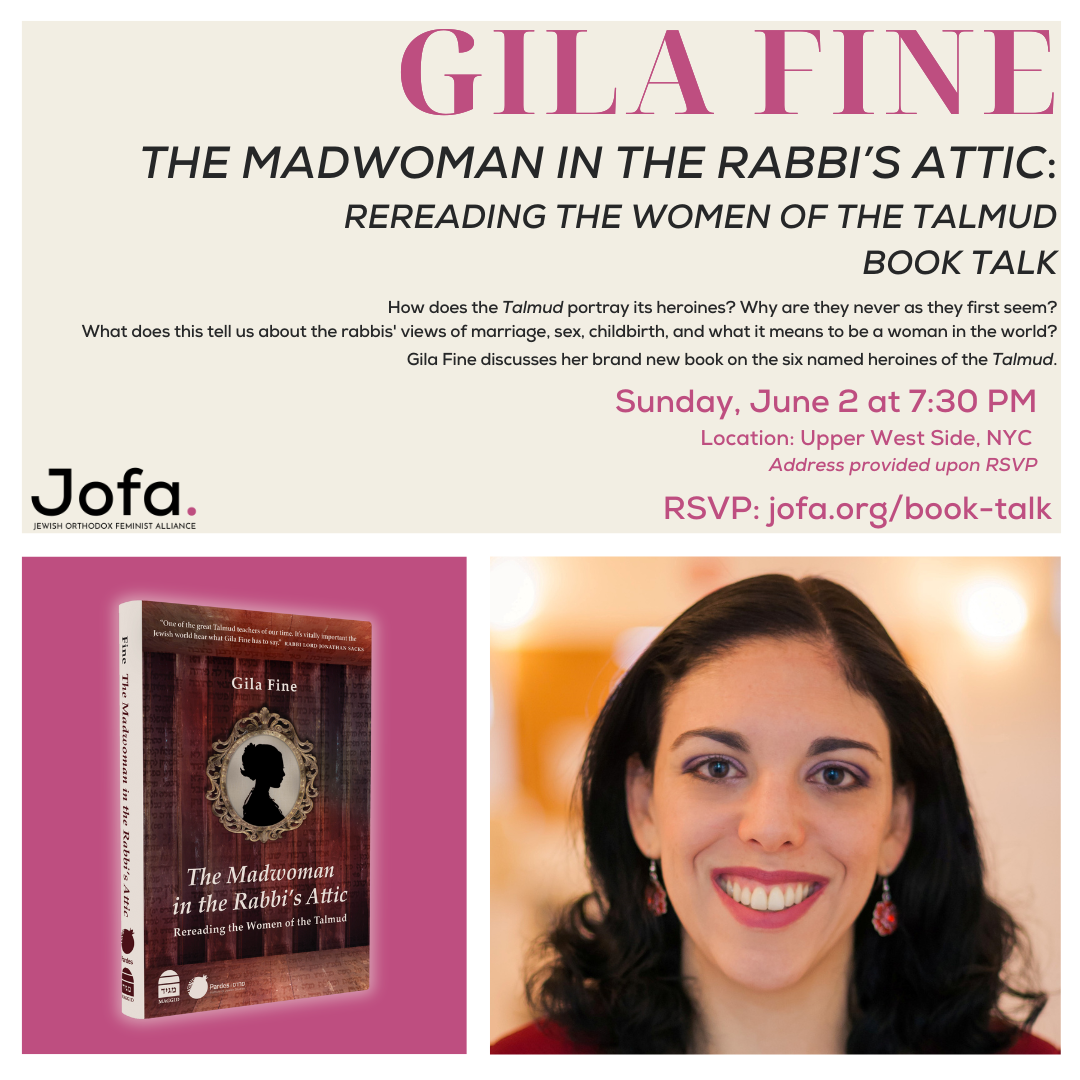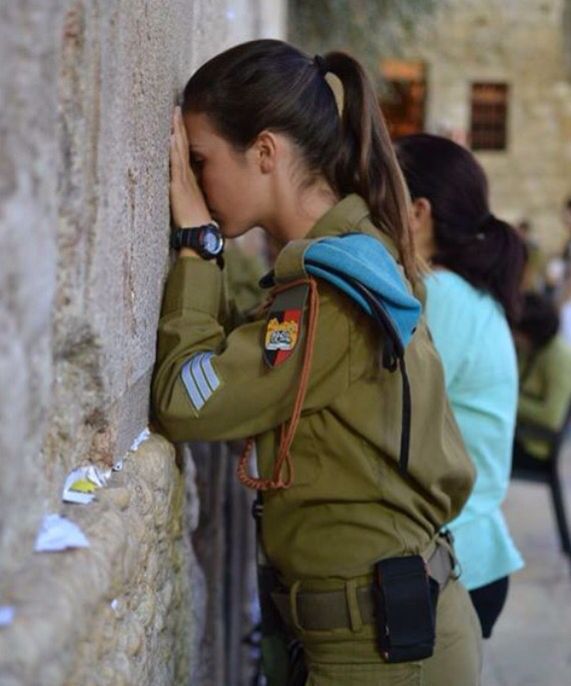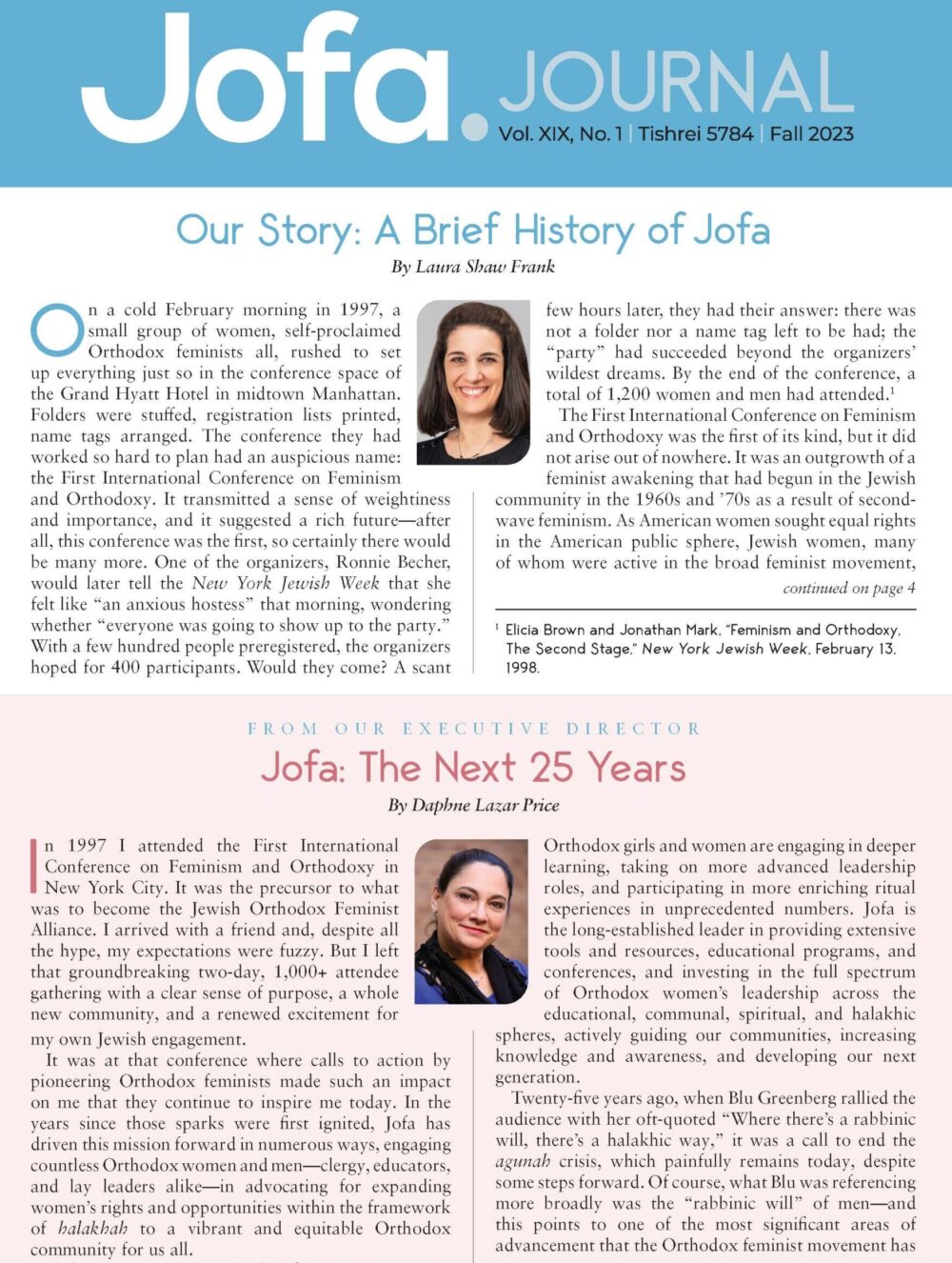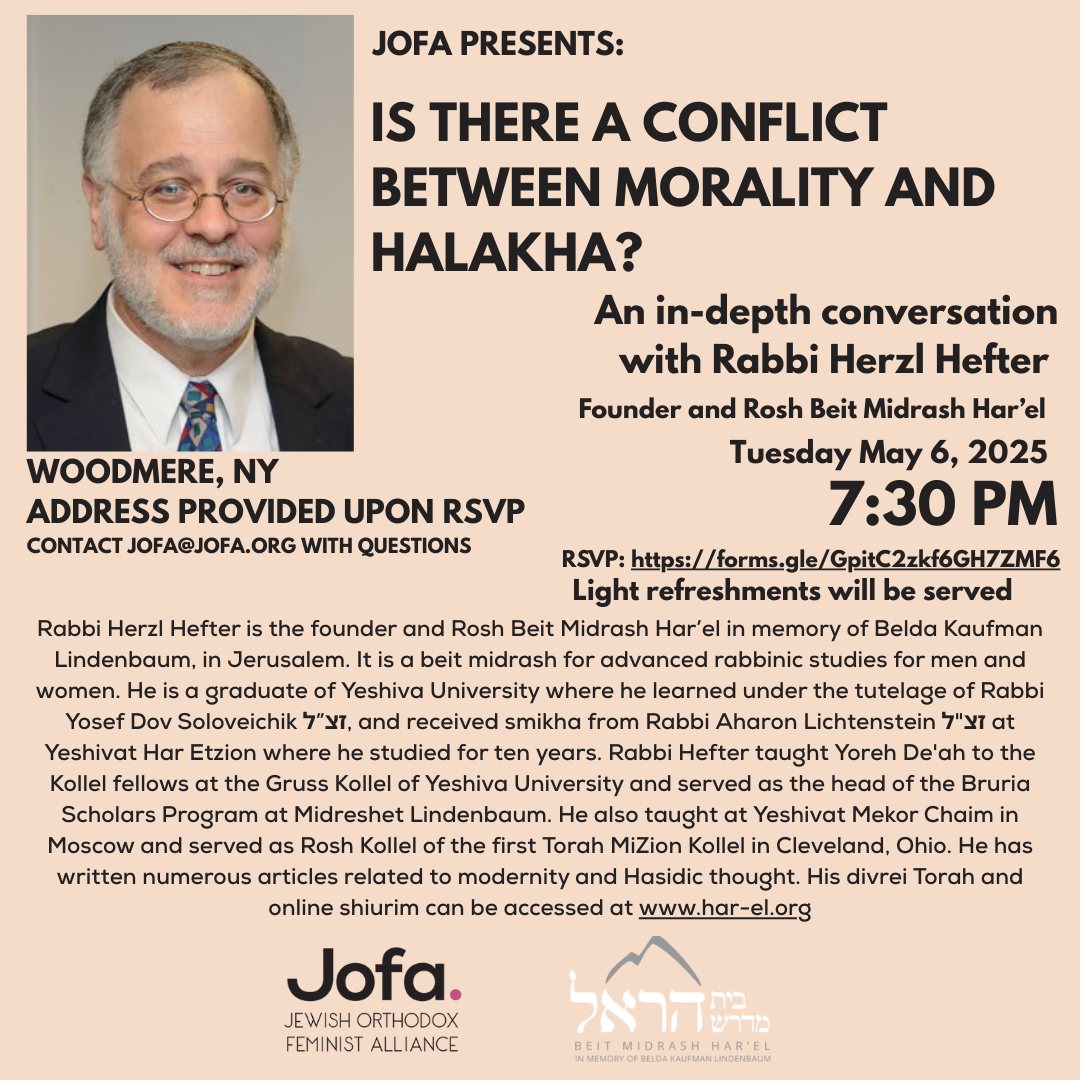Our Story: A Brief History of Jofa
On a cold February morning in 1997, a small group of women, self-proclaimed Orthodox feminists all, rushed to set up everything just so in the conference space of the Grand Hyatt Hotel in midtown Manhattan. Folders were stuffed, registration lists printed, name tags arranged. The conference they had worked so hard to plan had an auspicious name: the First International Conference on Feminism and Orthodoxy. It transmitted a sense of weightiness and importance, and it suggested a rich future—after all, this conference was the first, so certainly there would be many more. One of the organizers, Ronnie Becher, would later tell the New York Jewish Week that she felt like “an anxious hostess” that morning, wondering whether “everyone was going to show up to the party.” With a few hundred people preregistered, the organizers hoped for 400 participants. Would they come? A scant few hours later, they had their answer: there was not a folder nor a name tag left to be had; the “party” had succeeded beyond the organizers’ wildest dreams. By the end of the conference, a total of 1,200 women and men had attended.1
The First International Conference on Feminism and Orthodoxy was the first of its kind, but it did not arise out of nowhere. It was an outgrowth of a feminist awakening that had begun in the Jewish community in the 1960s and ’70s as a result of second- wave feminism. As American women sought equal rights in the American public sphere, Jewish women, many of whom were active in the broad feminist movement, began pushing for change in their Jewish communities, demanding expanded ritual inclusion and leadership roles in their synagogues and Jewish institutions of learning. And their demands bore fruit. In 1972, Hebrew Union College–Jewish Institute of Religion, the Reform Movement’s rabbinical school, ordained its first woman rabbi, Sally Priesand. Change also began to take place, albeit a bit more slowly and painfully, in the Conservative movement. Many Conservative synagogues became egalitarian, allowing women to count in minyanim, lead services, and read from the Torah, and finally, in 1985, the Jewish Theological Seminary ordained Amy Eilberg, its first woman rabbi. Although women were not yet equally represented in the Reform or the Conservative rabbinates, and certainly women were woefully underrepresented as senior rabbis of large congregations and in rabbinic leadership of the movements, by the 1980s the feminist movement had certainly fomented enormous change in both movements.
Although Orthodox Judaism2 prides itself on maintaining tradition in the face of modern ideas, in fact, the feminist movement deeply affected Orthodox Jewish life as well. To begin with, it changed girls’ education. Until the 1970s and ’80s, the vast majority of Orthodox girls in America did not receive the same Jewish education as their male counterparts. Very few Orthodox day schools taught Talmud to girls, and most schools had separate-gender Judaic studies classes, which led to girls receiving a watered- down Jewish education. In 1977, Rabbi Joseph B. Soloveitchik, known as “the Rav,” who had a long-standing commitment to coeducation and Talmud education for girls, began teaching Talmud at Stern College, the women’s college of Yeshiva University. To be sure, the Rav did not cite feminism as a reason for teaching Talmud at Stern. However, there is no question that unequal education for girls had become more and more difficult to defend by the 1970s. Other institutions of higher Jewish learning for Orthodox women committed to teaching Talmud and other Jewish texts on the highest levels, including Drisha and Michlelet Bruria (now Midreshet Lindenbaum), were founded in the 1970s and ’80s. This change in Orthodox women’s Jewish education had a significant impact. First, more educated women were able to discuss women’s issues with rabbis from a position of knowledge and, therefore, of power. Second, highly educated Orthodox women began to think about credentialing. After all, if they received illustrious degrees for their years of higher education in the secular realm, and if their male counterparts received semikhah and the honor accorded to rabbis for their years of higher education in yeshiva, then perhaps women, too, deserved titles for their Jewish learning expertise.
Orthodox women’s education was not the only change in Orthodox communities arising from the feminist movement. Two other significant changes occurred. First, Orthodox women began organizing to advocate for agunot, women chained to dead marriages because their husbands refused to grant them a get, a Jewish divorce. As American states increasingly moved to no- fault divorce in the 1970s, Jewish divorce law, with its baked-in inequality for women, began to stand out as more and more problematic. Orthodox women, taking techniques from the feminist playbook, began to push back. Second, beginning in the 1960s and ’70s, Orthodox women, wanting deeper involvement with Jewish ritual, began organizing women’s tefillah groups, prayer services and Torah readings led by women. Although their numbers were not large, Orthodox women in Manhattan, Riverdale, Baltimore, and other places met regularly to engage in women’s tefillah, sometimes with the approval of their synagogue rabbis, but mostly without, and sometimes even without their knowledge. Women’s tefillah groups became places for women to celebrate life-cycle events such as bat mitzvahs, aufrufen, and baby namings. Despite great disapproval by most Orthodox rabbinic authorities, by the mid-1990s there were approximately 40 women’s tefillah groups in existence around the world.
Perhaps one of the most important impacts of the feminist movement on Orthodoxy was the awakening that it stirred in a self-proclaimed formerly “mild-man- nered yeshiva girl” named Blu Greenberg. Greenberg, a rebbetzin and mother of five, began thinking about how to marry the deep traditionalism of the Orthodox Juda- ism so beloved to her with new ideas about women’s equality and inclusion. In 1981, she published her now- famous book On Women and Judaism: A View from Tradition, in which she carefully and sensitively laid out the case for a feminist Orthodox Judaism. Blu’s vision and fortitude, in many ways, carried Orthodox femi- nism forward.
To be sure, a key difference between the impact of feminism in the liberal denominations of Judaism and Orthodoxy was the degree to which change was embraced by movement leadership. Whereas Reform and Conservative leaders may have initially been reticent to make change, they ultimately came around, and institutional change occurred. Orthodox leaders were different. Fearful of dilution of tradition, they opposed nearly all changes requested and made by women, often labeling those changes dangerous and against Jewish tradition.
All these developments in Orthodox Judaism contributed to the decision by a group of Orthodox feminists—Blu Greenberg, Esther Farber, Belda Lindenbaum, Ronnie Becher, and Bat Sheva Marcus among them—to think about organizing the First International Conference on Feminism and Orthodoxy to take place in New York City on February 16 and 17, 1997. Registrations came in at a steady pace, and it seemed as though there would be a respectable few hundred attendees for the two-day conclave. But then an unexpected event changed everything. On January 14, one month before the gathering, the Vaad Harabonim of Queens, New York issued a one-page resolution banning women’s tefillah groups.
Founded in November 1995, the Queens Women’s Tefillah Group had not encountered much opposition until that point. Meeting quietly once a month in the home of founder Sharon Kalker, the group had received the rabbinic approbation of the well-respected Orthodox scholar and rabbi, Simcha Krauss, spiritual leader of Young Israel of Hillcrest. But when the mother of an 11-year-old girl began planning a bat mitzvah to take place on January 18, 1997, in the women’s tefillah group, a storm ensued. The bat mitzvah girl invited her friends to the event, including her classmates at Yeshiva of Central Queens (YCQ). The school’s administration did not know what to do. Although women gathering to pray together was not all that controversial (indeed, girls often prayed as a group in yeshiva day schools each morning), the bat mitzvah girl planned to read from the Torah, something that was strongly opposed by the mainstream Orthodox leadership. Many of the parents of the girls invited to the simḥah worried about whether their daughters should attend. In advance of the bat mitzvah, YCQ’s administration asked the Vaad Harabonim for a ruling on whether such a women’s tefillah was permissible.3
The Vaad held a vote at its monthly meeting on January 14, four days before the bat mitzvah. Forty- seven rabbis attended. Rabbi Krauss and one other rabbi voted in favor of permitting the women’s tefillah group, including Torah reading. Three rabbis abstained, and two left before the vote. The rest voted to ban women’s tefillah in Queens. The group issued a resolution that acknowledged that the women attending the group had a sincere desire to express themselves religiously, but stated that women reading Torah was a breach of tradition and could not be countenanced. The resolution did not stop the bat mitzvah from going forward; it took place as planned, with more than 100 women and girls in attendance. Furthermore, far from squelching the group, the resolution spurred an enormous increase in interest in attending. In fact, the uproar extended well beyond the boundaries of Queens. In the wake of the declaration, the group organizing the First International Conference on Feminism and Orthodoxy suddenly received a surge in registrations for the conference. An awakening was occurring in the Orthodox community at just the right time.
The First International Conference on Feminism and Orthodoxy was a tremendous success. There was enormous excitement in the air as well over 1,000 women and men attended plenaries and breakout sessions, many with standing room only, which addressed everything from women’s prayer to agunot, to life-cycle rituals, to Orthodox feminism around the world. In the wake of the conference, the organizers, exhausted but energized, began to think about next steps. How could they capitalize on and continue the electric energy at the conference? Perhaps, they thought, it was time to found a new Orthodox feminist organization, one that would take on, in a holistic fashion, the many issues that Orthodox women faced.
Gathering a group of women to serve as the inaugural board of directors, the conference organizers set about discussing what such an organization would look like. To begin with, there was much discussion about what to name it. When no clear choice emerged, the founders decided to give the organization the temporary name JOFA: Jewish Orthodox Feminist Alliance. They figured they could always change it later; none of them ever imagined that the name would stick, becoming a household word in many an Orthodox home in America. The original board of directors was a group of thirteen women, ranging in age from their twenties to their fifties. All lived in New York City—five from Riverdale, five from Manhattan, and three from Brooklyn. Blu Greenberg, the matriarch of Orthodox feminism, was named the first president, and Jofa was born.
In July 1997, the group went public with their plans. In an interview with the New York Jewish Week, Blu Greenberg laid out a robust agenda for Jofa. First, the organization would serve as a clearinghouse for new life-cycle rituals, such as baby-naming ceremonies for daughters and prayers for Orthodox women at various points in their lives (such as childbirth), as well as a prayer to recite on behalf of agunot, women chained to dead marriages. It would also keep lists of rabbis who were helpful to Orthodox women, as well as rabbis who were “doing negative things against them.” Jofa would partner with other organizations to combat domestic violence and the agunah problem in the Orthodox community, and it would not shy away from working with women from other denominations of Judaism. News of the new organization was not well received by Orthodox leadership. Rabbi Raphael Butler, the executive vice president of the Orthodox Union, said, “The place to address these issues is through the infrastructure” that already existed in the Orthodox community. Claiming that the community was already addressing the concerns raised by the nascent organization, Rabbi Butler argued that the Orthodox community should not have to “splinter into additional initiatives to somehow redefine the center.” Jofa board members were unconvinced by Rabbi Butler’s arguments. They noted that women would have worked through the existing Orthodox establishment if they had been able to do so.4
Capitalizing on the success of the 1997 inaugural conference, Jofa de- cided to hold another conference in February 1998. The Second Inter- national Conference on Feminism and Orthodoxy was as successful as the first. This time, the organiz- ers planned for 1,000 attendees, but they were once again surprised when 2,000 attended over the course of the two-day gathering. Over the follow- ing twenty-five years, Jofa convened ten International Conferences on Feminism and Orthodoxy (including one virtual confer- ence), as well as regional conferences and other smaller gatherings. Each event reflected the growth and change in the Orthodox community that resulted from Jofa’s work. Between conferences, Jofa created programs, ini- tiatives, and advocacy efforts—some public and others more quiet—to advance its agenda. Beginning with a shoestring budget and no professional staff, it grew to be a well-established organization with a significant budget and a three-person staff: an executive director, a program director, and a communications director. Through education, raising of awareness, program- matic initiatives, and advocacy, Jofa has brought about enormous change in its priority areas in the Orthodox world over these years.
Women’s Spiritual Leadership
In 1984, Blu Greenberg published an article in Judaism magazine titled “Will There Be Orthodox Women Rabbis?” Her answer was a careful but still prescient “yes.” By the 1997 First International Conference, though, little progress had been made in achieving that dream. In fact, one conference speaker told the New York Times that she was “warned not to utter the words ‘women in the rabbinate.’”5 In the wake of the conference, however, things began to change. In 1997, Nishmat, a midrashah for women’s learning in Israel, began its yoatzot halakhah program, training women to answer questions about taharat hamishpaḥah, the Jewish laws of family purity that govern the sexual relationship of husbands and wives in concert with the wife’s menstrual cycle. Whereas Nishmat’s leaders were unequivocal in their stance that the yoatzot were not poskot, decisors of Jewish law, but merely those with training to apply the decisions of rabbinic authorities, there was no question that the program opened up an avenue for learned Orthodox women to engage in spiritual leadership. Notably, Rabbanit Chana Henkin, the founder and rosh midrashah of Nishmat, and certainly not a left-winger in the Orthodox world, spoke at Jofa’s Second International Conference.
In early 1998, Rabbi Adam Mintz of Lincoln Square Synagogue in Manhattan and Rabbi Avi Weiss of the Hebrew Institute of Riverdale each appointed a woman to be a “congregational intern,” a newly created spiritual leadership role for women. Although they were modeled on rabbinic interns— rabbinical students who intern with established rabbis in synagogues to learn practical rabbinics— congregational interns differed in one key way: They were relegated to permanent intern status; they could not hope for any permanent position. Nonetheless, their appointment marked the first time that any Orthodox shul had created a credentialed spiritual leadership role for a woman. Weeks after the announcement of the congregational interns, at the Second International Conference on Feminism and Orthodoxy, an entire panel was devoted to the topic of women rabbis, a far cry from the previous year.6 One of the panelists was Rabbi Mintz, who reported that he intended to tell the audience “in no uncertain terms, ‘a woman cannot be ordained.’”7 (Rabbi Mintz later became a member of the Talmud faculty at Yeshivat Maharat.)
Change continued in the ensuing years. In 1999, no doubt due at least in part to pressure to offer higher Jewish education for women, Stern College of Yeshiva University announced the founding of its Graduate Program in Advanced Talmudic Studies (GPATS), a program affording women the opportunity to learn Talmud on the highest levels, although without any particular credential offered upon completion of the program. At each conference, Jofa pushed the agenda of Orthodox women rabbis, inviting speakers to discuss the issue from different aspects and angles. Board meetings often featured discussions, both planned and off-the-cuff, about how to move the needle.
A breakthrough finally happened in 2009 when Sara Hurwitz was conferred with semikhah by Rabbi Avi Weiss. Later that year, Rabba Hurwitz and Rabbi Weiss opened Yeshivat Maharat, a yeshiva that would ordain Orthodox women as clergy.8 Jofa stood staunchly behind Rabbi Weiss and Rabba Hurwitz, even as many authorities in the Orthodox world condemned their work. Following the opening of Maharat, Jofa, and Maharat often worked hand in hand to advance opportunities for women clergy by subsidizing some of the early pulpit positions. Zelda Stern, who had joined the Jofa board in 1998 and also served on Maharat’s initial board, was central to this effort by providing seed funding that helped make such positions financially possible for the synagogues and for the women clergy. Jofa consistently gave platforms to those involved in the ordination of women. At the first conference after Rabba Hurwitz’s ordination in 2010, she was given an honored plenary slot to speak. As she was called to the stage with her full title, Rabba Sara Hurwitz, she was greeted with a standing ovation by the hundreds of men and women in the room.9 Every conference thereafter has featured many speaking slots for those involved with advancing the cause of women’s spiritual leadership in Orthodoxy, from the women rabbis themselves to rabbinical students, faculty, and those hiring them for rabbinic roles.
In 2020, noticing that synagogues often reported willingness to hire female clergy but lacked funds to do so, Jofa announced a new initiative called Devorah Scholars, funded by longtime board member Ann Pava, which offered seed money to a select number of synagogues to help them hire a female clergyperson. Importantly, the Devorah Scholars project cast a wide net, enabling funding for positions filled not only by women ordained by Maharat or other credentialing yeshivot in Israel, but also by GPATS graduates or yoatzot halakhah. This policy intentionally seeded women’s spiritual leadership positions beyond the usual left-leaning Orthodox communities.10
Women’s Participation in Ritual and Synagogue Life
Beginning in 1997, and continuing forward, Jofa prioritized creating both resources and opportunities for women to participate in prayer and Jewish ritual in meaningful ways. Conferences offered sessions on creating meaningful rituals around life-cycle events such as bat mitzvahs, weddings, baby namings, menopause, and end of life. From the first conference onward, women’s tefillah was offered as an option for Shaḥarit services in the morning. When planning the 2002 conference, the planning committee made sure to include a panel on the new concept of the partnership minyan, a type of service that arose out of a hotly debated article in the Edah Journal by Rabbi Mendel Shapiro, which made the case that women could halakhically be called to the Torah for aliyot .11 From the 2004 conference onward, partnership minyanim were offered as another option for Shaḥarit services.12 Jofa maintained a list of women’s tefillah groups and partnership minyanim on its website, so that anyone who wanted to find one could do so. Not satisfied with only offering opportunities to participate, Jofa also nurtured women’s abilities to lead services and read Torah and other texts. It offered periodic workshops at conferences and in other fora on how to run partnership minyanim and created an interactive app to teach women to read Megillat Esther; now, recordings of all the megillot are available on Jofa’s website.
Jofa also seeded research and writing on halakhot regarding women and ritual. With grants from Dr. Monique Katz and Gail Katz, both long-time Jofa board members, Jofa published two volumes called Hilkhot Nashim Halakhic Source Guides, with articles by learned Orthodox women on topics such as women and Kiddush, women and Mourners’ Kaddish, and many others. These resource guides empowered women and men who seek to increase women’s engagement with Jewish ritual with deep knowledge of the halakhic sources at issue.
The Agunah Issue
Perhaps the issue that has most frustrated Jofa leadership throughout its history has been its perceived inability to make real change with respect to the issue of agunot. Blu Greenberg, speaking about the issue, had famously—and controversially—declared, “Where there is a rabbinic will, there is a halakhic way.” Yet despite seemingly endless efforts to foster that will in the Orthodox rabbinate, Jofa board members felt that they were achieving nothing. However, looking back at Jofa’s history, it becomes clear that, in fact, change did occur. In the early years of Jofa, it was difficult, at best, to get Orthodox rabbis to pay attention to the issue of agunot, much less to do something to ameliorate the situation. But as Jofa, alongside agunah rights activists and organizations, raised the issue again and again, ultimately Orthodox rabbis were no longer able to turn their backs.
At Jofa’s 2007 conference, Israeli scholar and Orthodox feminist Tova Hartman declared, “Let this be the last Jofa conference where we need to ask if there’s a halakhic heter for agunot!” The crowd roared its approval.13 Whereas Hartman eventually got her wish— by the 2010 conference, female and male scholars were able to report that indeed there were halakhic solutions to the problem—getting rabbis to use those solutions was another matter entirely. At first, change came in the form of the halakhic prenup, a civil contract that imposed penalties on men who refused to give their wives a get after being ordered to do so by a beit din. In 2012, the International Rabbinic Fellowship (IRF), a group of rabbis from the more liberal wing of Orthodoxy, many of whom were graduates of Yeshivat Chovevei Torah, passed a resolution requiring that its members insist upon the signing of a halakhic prenup for any wedding at which they officiated. At that time, the Rabbinical Council of America (RCA), the centrist Orthodox rabbinic body, declined to require the prenup. Rabbi Shmuel Goldin, RCA president, praised the IRF’s decision, but said it would be counterproductive for the RCA to follow suit because most members already required it, and those who were reticent would end up leaving the RCA if it were mandated.14
In an attempt to build serious momentum in the wake of the IRF’s resolution, in June 2013, Jofa organized and cosponsored an Agunah Summit together with the Tikvah Center for Law and Jewish Civilization at New York University. The summit, the first of its kind, brought together agunah activists, rabbis, and legal scholars to discuss systemic halakhic and secular legal solutions to the problem of agunot. There was enormous excitement in the halls of the gathering. As Blu Greenberg noted, “There was a tremendous amount of rabbinic consensus that we have to get our community behind [solving] this.”15 The conference brought about significant change. First, it resulted in the 2014 founding of the International Beit Din, a beit din that employed halakhic and extra-halakhic solutions to solve the agunah problem. The founding av beit din was none other than Rabbi Simcha Krauss, zt”l, the rabbi who had long ago supported the Women’s Tefillah Group of Queens. Second, in 2016, four years after declining to do so, the RCA passed a resolution requiring the halakhic prenup. No doubt, communal pressure, due in large part to Jofa’s advocacy and education in this area, affected their decision. Although the agunah problem has not entirely been solved, the situation is far better than it was when Jofa began its work in 1997.
Marginalized Sub-Communities
Over its history, Jofa also has given voice to the experiences of many women who felt marginalized by the mainstream Orthodox community. From its inception, Jofa highlighted the experiences of single and divorced women, as well as women experiencing infertility, three groups who often have felt invisible in Orthodox spaces, where most women were married and became mothers of children at young ages. Although Jofa was at first a bit worried about taking up the issue of Orthodox lesbian women, it held a session on lesbianism in the Orthodox community at the 2002 conference, which was highly successful. In the ensuing years, Jofa increasingly offered a platform to members of the Orthodox LGBTQ+ community, raising awareness about their concerns and increasing their visibility and inclusion in Orthodox spaces.
Recently, in the wake of the overturning of Roe v . Wade by the United States Supreme Court, Jofa launched the Rivka Isaacs S.A.F.E. Plan, an abortion access resource network aimed at helping all women in states where abortion is no longer legal to obtain “culturally congruent abortion care support.” In so doing, Jofa took the issue of abortion, often hidden and not discussed in Orthodox communities, out of the shadows and offered support to the many Orthodox and non-Orthodox women, as well as to all women at large, who need or want abortion services.
Charting New Ground
The landscape of the Orthodox community is vastly different from what it was on that cold February day in 1997. Modern Orthodoxy is more inclusive of diversity, more educated about women’s issues, and more open to women’s leadership than the founders of Jofa could ever have imagined. As Jofa continues into its second quarter century, it will continue to chart new ground for Orthodox women, ensuring the health and success of Orthodox communities into the future.
Laura Shaw Frank is the director of the William Petschek Contemporary Jewish Life Department at the American Jewish Committee (AJC), where she works on the thriving and resilience of the American Jewish community . She is a proud founding board member of Jofa.
1 Elicia Brown and Jonathan Mark, “Feminism and Orthodoxy, The Second Stage,” New York Jewish Week, February 13, 1998.
2 This article uses the term “Orthodox” to refer to Modern/ Centrist Orthodoxy and not yeshivish or ḥareidi Orthodoxy. The impact of feminism in those communities is deserving of scholarly treatment, but that topic is beyond the scope of this article.
3 Norimitsu Onishi, “Reading the Torah, an Orthodox Women’s Group Takes On Tradition,” New York Times, February 16, 1997, p. 43; Debra Nussbaum Cohen, “Ban on Women’s Prayer Groups Sparks Outcry—and New Interest,” New York Jewish Week, February 4, 1997.
4 Saundra Mandel, “Successful Conference Spurs New Orthodox Feminist Alliance,” NY Jewish Week, July 4, 1997.
5 Laurie Goodstein, “Unusual, but Not Unorthodox; Causing a Stir, 2 Synagogues Hire Women to Assist Rabbis,” New York Times, Feb. 6, 1998, B1.
6 Goodstein, op. cit.
7 Brown and Mark, “Feminism and Orthodoxy, The Second Stage,” op. cit.
8 Laura Shaw Frank, “Yeshivat Maharat,” The Shalvi/Hyman Encyclopedia of Jewish Women, www.jwa.org (2021).
9 Ben Harris, “At JOFA conference, passion shifts to women’s leadership,” Jewish Telegraphic Agency, March 16, 2010.
10 Daphne Lazar Price, “Jofa’s Devorah Scholars Program: Making Space for Women Leaders in Orthodox Synagogues,” https://slingshotfund.org/post/jofas- devorah-scholars-program-making-space-for-women- leaders-in-orthodox-synagogues/.
11 Mendel Shapiro, “Qeri’at ha-Torah by Women: A Halakhic Analysis,” Edah Journal, Vol. 1:2, Sivan 5761, pp. 1–52.
12 Minutes, Jofa Conference Planning Committee Meeting, June 11, 2009.
13 Harris, 2010.
14 Debra Rubin, “Rabbinic Group Requiring Prenuptial Agreements,” Jewish Telegraphic Agency, May 29, 2012
15 Jillian Scheinfeld, “Agunah Summit pushes for answers,” Jewish Telegraphic Agency, June 27, 2013.

